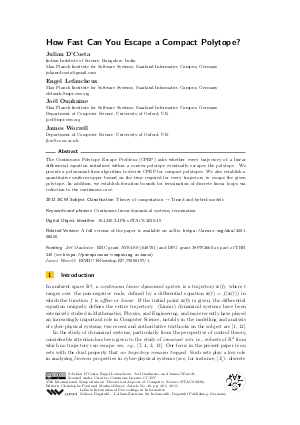How Fast Can You Escape a Compact Polytope?
Authors Julian D'Costa, Engel Lefaucheux, Joël Ouaknine, James Worrell
-
Part of:
Volume:
37th International Symposium on Theoretical Aspects of Computer Science (STACS 2020)
Part of: Series: Leibniz International Proceedings in Informatics (LIPIcs)
Part of: Conference: Symposium on Theoretical Aspects of Computer Science (STACS) - License:
 Creative Commons Attribution 3.0 Unported license
Creative Commons Attribution 3.0 Unported license
- Publication Date: 2020-03-04
File

PDF
LIPIcs.STACS.2020.49.pdf
- Filesize: 488 kB
- 11 pages
Document Identifiers
Related Versions
-
A full version of the paper is available on arXiv, https://arxiv.org/abs/2001.08200.
Subject Classification
ACM Subject Classification
- Theory of computation → Timed and hybrid models
Keywords
- Continuous linear dynamical systems
- termination
Metrics
- Access Statistics
-
Total Accesses (updated on a weekly basis)
0Document
0Metadata
Abstract
The Continuous Polytope Escape Problem (CPEP) asks whether every trajectory of a linear differential equation initialised within a convex polytope eventually escapes the polytope. We provide a polynomial-time algorithm to decide CPEP for compact polytopes. We also establish a quantitative uniform upper bound on the time required for every trajectory to escape the given polytope. In addition, we establish iteration bounds for termination of discrete linear loops via reduction to the continuous case.
Cite As Get BibTex
Julian D'Costa, Engel Lefaucheux, Joël Ouaknine, and James Worrell. How Fast Can You Escape a Compact Polytope?. In 37th International Symposium on Theoretical Aspects of Computer Science (STACS 2020). Leibniz International Proceedings in Informatics (LIPIcs), Volume 154, pp. 49:1-49:11, Schloss Dagstuhl – Leibniz-Zentrum für Informatik (2020)
https://doi.org/10.4230/LIPIcs.STACS.2020.49
BibTex
@InProceedings{dcosta_et_al:LIPIcs.STACS.2020.49,
author = {D'Costa, Julian and Lefaucheux, Engel and Ouaknine, Jo\"{e}l and Worrell, James},
title = {{How Fast Can You Escape a Compact Polytope?}},
booktitle = {37th International Symposium on Theoretical Aspects of Computer Science (STACS 2020)},
pages = {49:1--49:11},
series = {Leibniz International Proceedings in Informatics (LIPIcs)},
ISBN = {978-3-95977-140-5},
ISSN = {1868-8969},
year = {2020},
volume = {154},
editor = {Paul, Christophe and Bl\"{a}ser, Markus},
publisher = {Schloss Dagstuhl -- Leibniz-Zentrum f{\"u}r Informatik},
address = {Dagstuhl, Germany},
URL = {https://drops.dagstuhl.de/entities/document/10.4230/LIPIcs.STACS.2020.49},
URN = {urn:nbn:de:0030-drops-119105},
doi = {10.4230/LIPIcs.STACS.2020.49},
annote = {Keywords: Continuous linear dynamical systems, termination}
}
Author Details
- Indian Institute of Science, Bangalore, India
- Max Planck Institute for Software Systems, Saarland Informatics Campus, Germany
- Max Planck Institute for Software Systems, Saarland Informatics Campus, Germany
- Department of Computer Science, University of Oxford, UK
Funding
- Ouaknine, Joël: ERC grant AVS-ISS (648701) and DFG grant 389792660 as part of TRR 248 (see https://perspicuous-computing.science).
- Worrell, James: EPSRC Fellowship EP/N008197/1.
References
-
R. Alur. Principles of Cyber-Physical Systems. MIT Press, 2015.

-
A. Bacciotti and L. Mazzi. Stability of dynamical polysystems via families of Lyapunov functions. Jour. Nonlin. Analysis, 67:2167-2179, 2007.

-
P. C. Bell, J.-C. Delvenne, R. M. Jungers, and V. D. Blondel. The continuous Skolem-Pisot problem. Theor. Comput. Sci., 411(40-42):3625-3634, 2010.

- V. Blondel and J. Tsitsiklis. A survey of computational complexity results in systems and control. Automatica, 36(9):1249-1274, 2000. URL: https://doi.org/10.1016/S0005-1098(00)00050-9.
-
M. Braverman. Termination of integer linear programs. In Proc. Intern. Conf. on Computer Aided Verification (CAV), volume 4144 of LNCS. Springer, 2006.

- J.-Y. Cai. Computing Jordan normal forms exactly for commuting matrices in polynomial time. Int. J. Found. Comput. Sci., 5(3/4):293-302, 1994. URL: https://doi.org/10.1142/S0129054194000165.
-
E. B. Castelan and J.-C. Hennet. On invariant polyhedra of continuous-time linear systems. IEEE Transactions on Automatic Control, 38(11):1680-85, 1993.

-
Ventsislav Chonev, Joël Ouaknine, and James Worrell. On recurrent reachability for continuous linear dynamical systems. In Proceedings of the 31st Annual ACM/IEEE Symposium on Logic in Computer Science, LICS '16, New York, NY, USA, July 5-8, 2016, pages 515-524, 2016.

-
Ventsislav Chonev, Joël Ouaknine, and James Worrell. On the Skolem Problem for continuous linear dynamical systems. In 43rd International Colloquium on Automata, Languages, and Programming, ICALP 2016, July 11-15, 2016, Rome, Italy, pages 100:1-100:13, 2016.

-
E. Hainry. Reachability in linear dynamical systems. In Logic and Theory of Algorithms, 4th Conference on Computability in Europe, CiE 2008, Athens, Greece, June 15-20, 2008, Proceedings, pages 241-250, 2008.

- J. Ouaknine, J. Sousa Pinto, and J. Worrell. On the polytope escape problem for continuous linear dynamical systems. In Proceedings of the 20th International Conference on Hybrid Systems: Computation and Control, HSCC 2017, Pittsburgh, PA, USA, April 18-20, 2017, pages 11-17, 2017. URL: https://doi.org/10.1145/3049797.3049798.
-
André Platzer. Logical Foundations of Cyber-Physical Systems. Springer, 2018.

-
S. Sankaranarayanan, T. Dang, and F. Ivancic. A policy iteration technique for time elapse over template polyhedra. In Proceedings of HSCC, volume 4981 of LNCS. Springer, 2008.

-
Shai Shalev-Shwartz and Shai Ben-David. Understanding machine learning: From theory to algorithms. Cambridge university press, 2014.

-
A. Tiwari. Termination of linear programs. In Proc. Intern. Conf. on Comp. Aided Verif. (CAV), volume 3114 of LNCS. Springer, 2004.

